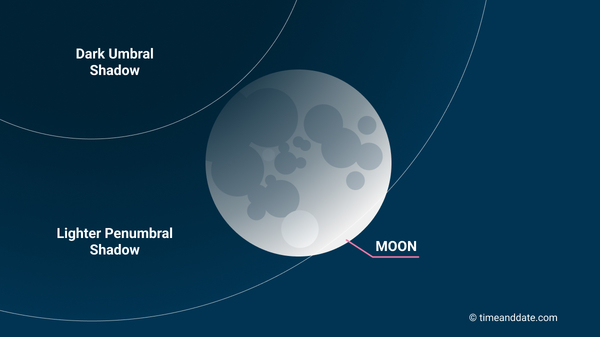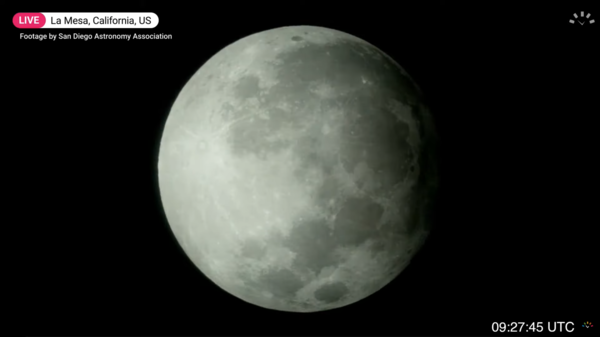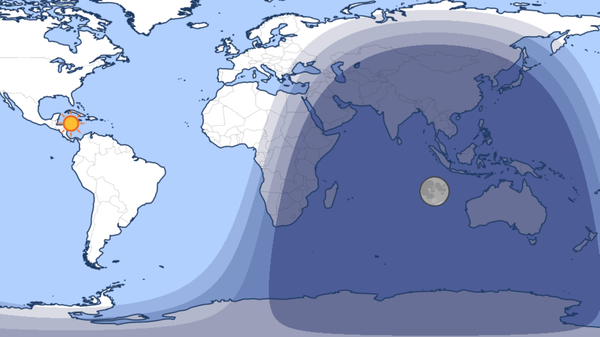May 2023 Eclipse: Moon Misses Earth’s Dark Shadow by 100 Miles
During a penumbral lunar eclipse on May 5, 2023, the Moon will pass within about 160 km (100 miles) of Earth’s umbral shadow.

On the night of May 5–6, 2023, the Moon will travel through the outer part of our planet’s shadow—but just miss the dark, inner part.
©timeanddate.com
Very Nearly a Partial Eclipse
As it travels around the Sun, planet Earth casts two large circular shadows out into space.
The darker, inner shadow is called the umbra. When the Moon passes through the umbra, it produces a partial or total lunar eclipse.
The lighter, outer shadow is called the penumbra. When the Moon passes through this shadow, the result is a much fainter penumbral eclipse.
During a penumbral eclipse on May 5, 2023, the Moon will pass within 160 km (100 miles) or so of Earth’s umbra.
How Much Is 100 Miles?
The diagram at the top of this page shows the maximum point of the May 2023 eclipse. The diagram is to scale, but it might be helpful to put the sizes into context.
At the time of maximum eclipse, the Moon is roughly 380,000 km (240,000 miles) from Earth. At this distance out in space, the size of Earth’s umbral shadow is about 9000 km (6000 miles) from one side to the other.
To miss it by 160 km (100 miles) is equivalent to missing a dart board by 8 millimeters (0.3 inches).
Is There Anything to See?
We cannot see the beginning and end of this eclipse, when the Moon enters and leaves the penumbra, because the shadow is too faint.
Around the maximum point of the eclipse, the edge of the Moon closest to the umbra will appear noticeably darker than the opposite edge.

This telescope view of a penumbral eclipse—taken from a timeanddate live stream in November 2020—shows how one side of the Moon can appear darker than the other.
©timeanddate.com
Who Can See It?
Lunar eclipses take place at Full Moon, when the Moon is on the opposite side of Earth to the Sun. Weather permitting, they are visible to anyone on the nighttime side of Earth.
The penumbral eclipse on May 5, 2023, reaches its maximum point at 17:22 UTC. Around this time, the nighttime side of Earth includes the eastern half of Africa, and most of Asia.
It also includes Australia and New Zealand, where maximum eclipse happens in the early hours of May 6.
(Alas, timeanddate is not live streaming this penumbral eclipse—although you’re welcome to re-watch our broadcast of the previous penumbral eclipse, in November 2020.)
Check the eclipse times for your city
Why does a lunar eclipse have two dates?

Our Day and Night World Map shows the daytime and nighttime parts of the globe at 17:22 UTC on May 5, 2023—the time of maximum eclipse.
©timeanddate.com
How Does This Penumbral Eclipse Compare to Others?
A more technical way of measuring how close the Moon gets to the umbra is to look at the umbral magnitude.
What Is Umbral Magnitude?
It is the fraction of the Moon’s diameter covered by Earth’s umbra at the moment of greatest eclipse.
For a partial lunar eclipse, the magnitude is between 0 and 1, because the umbra covers part of the Moon’s diameter. For a total eclipse, it is greater than 1, because all of the Moon’s diameter is covered.
For a penumbral eclipse, the umbral magnitude is less than 0 (in other words, it is a negative number). The closer the number is to 0, the closer the Moon gets to the umbra.
In the first half of the 21st century, there are 41 penumbral lunar eclipses. Of these, the May 2023 eclipse is the 4th closest ‘near miss’ between the Moon and Earth’s umbra.
Top 4 Moon-Umbra Near Misses, 2001–2050
| Rank | Date | Magnitude | |
|---|---|---|---|
| 1. | September 29, 2042 | -0.00334 | |
| 2. | March 3, 2045 | -0.01711 | |
| 3. | February 11, 2017 | -0.03574 | |
| 4. | May 5, 2023 | -0.04594 |
Penumbral eclipses ranked by umbral magnitude.
Source: timeanddate.com